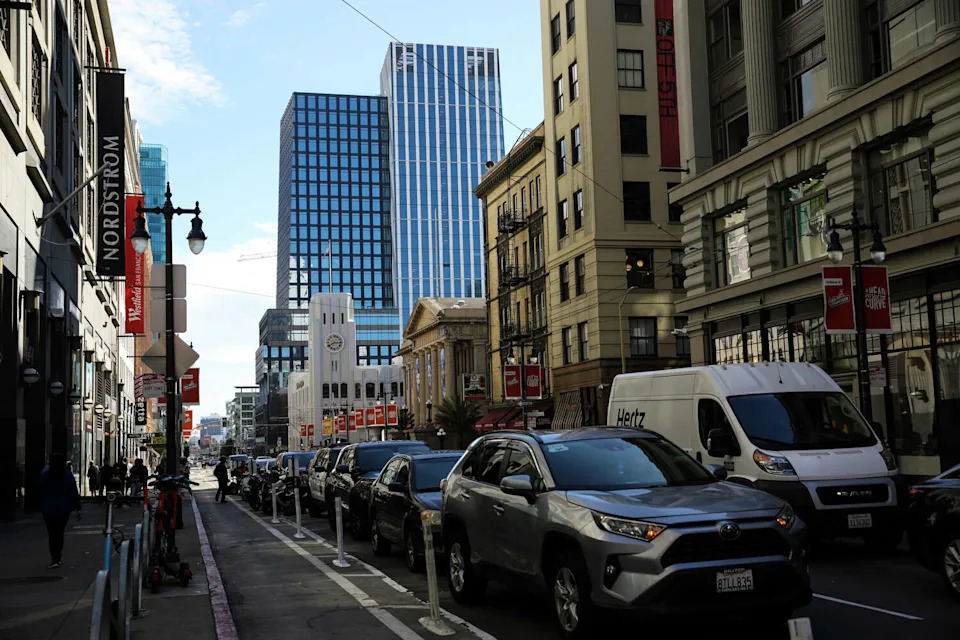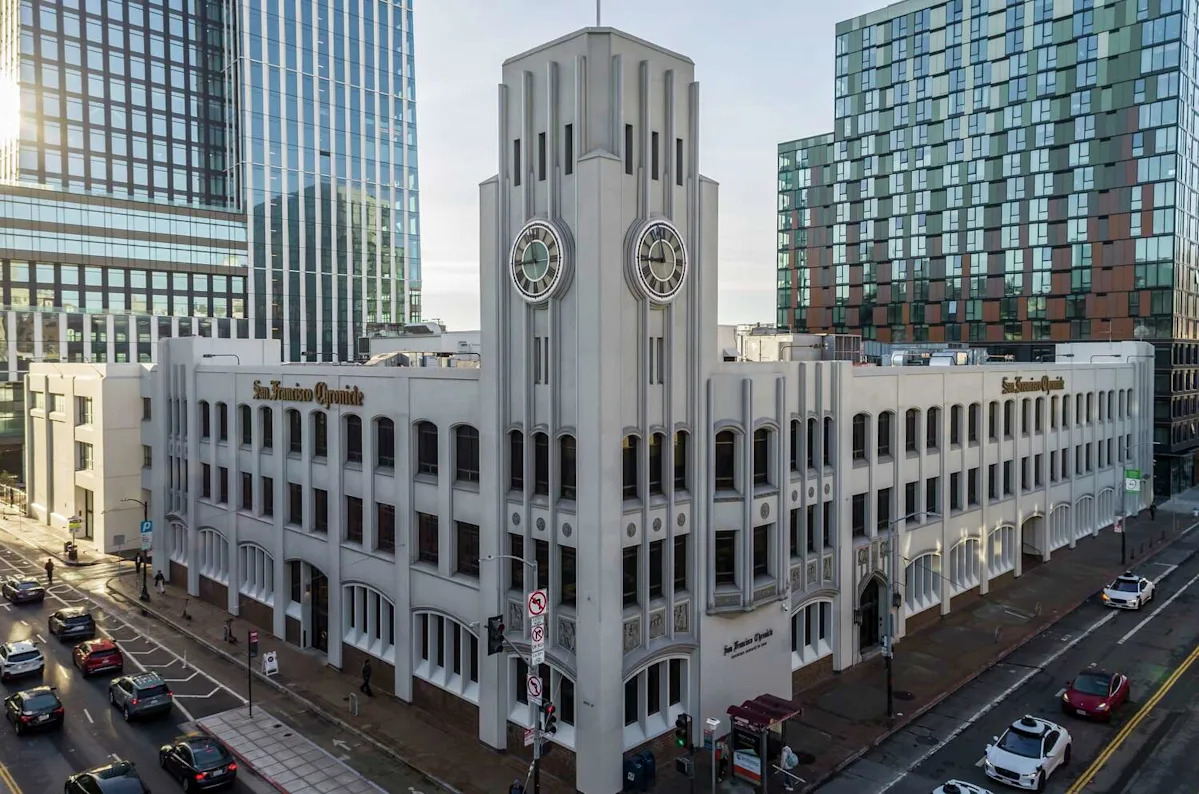The ambitious bid by one of the country’s top research universities to expand into downtown San Francisco appears to have focused on a signature block that’s struggled with vacancy, despite a longstanding plan to revitalize it.
Sources with insight into the effort have confirmed that Vanderbilt University in Nashville, Tenn., has been evaluating the area around Fifth and Mission streets, and that the 5M mixed-use project – including the Chronicle’s historic headquarters building at 901 Mission St. – could be the desired destination. New York-based Hearst Corp. owns the property as well as the Chronicle and SFGate, which is also headquartered at 901 Mission.
City officials confirmed to the Chronicle earlier this year that they’re in serious talks with Vanderbilt about opening a downtown campus, a move aimed at tackling soaring vacancies and diversifying San Francisco’s core. So far, details, such as where the planned satellite campus would be located, have remained elusive – perhaps because they’ve yet to be finalized.
However, according to multiple sources, 5M was discussed in connection with Vanderbilt’s plans and downtown’s larger recovery efforts in meetings with business leaders in recent months.

A view of the 415 Natoma and San Francisco Chronicle (with tower) buildings in San Francisco. The properties could be the target of a university looking to expand into the city. (Yalonda M. James/The Chronicle)
To some insiders, this won’t come as a surprise: The Fifth and Mission area was identified as a potential university campus site in a report prepared last year by the San Francisco Chamber of Commerce, which collaborated with architecture firm SOM and commercial brokerage JLL to study which portions of the city’s downtown are best suited for integrating a university.
Rodney Fong, CEO and President of the Chamber, said that the organization shared the report with the offices of both former mayor London Breed and current mayor Daniel Lurie, which is now working to help Vanderbilt land.
“The study looks at a couple different locations downtown, including around Salesforce (Tower). It looked at the Embarcadero, Jackson Square, and it really sort of arrived at the Fifth and Mission corridor for the core reasons of transportation,” Fong said, adding that “opportunity sites” in the area include 5M, The Mint building, the fading former Westfield mall, and the Fifth and Mission Garage.
Fong said that the clusters of properties studied could accommodate thousands of students, potentially from multiple universities.
David Harrison, director of Public Policy at the Chamber, emphasized that the “thesis” of the report was not just one, but several universities co-locating in downtown. “You could have two or three national universities (co-locate)…. And then feel really good about dorm conversions,” Harrison said.
Real estate insiders said last month they were tracking a requirement from Vanderbilt for roughly 150,000-square-feet of educational space with student housing opportunities in close proximity. Sources with insight into the effort described the vision for Vanderbilt’s San Francisco campus as an “artificial intelligence or tech center,” designed to tap into the momentum and innovation of the city’s growing AI startup scene. University representatives have neither confirmed this information nor commented on the campus’ potential designs or programming.
“We are excited about exploring a possible presence in San Francisco and deeply value our partnership with Mayor Lurie and his team. No decisions on location or real estate have been made,” a Vanderbilt spokesperson said in an email to the Chronicle last month.
“There are so many great places to have a university… We want them to pick what’s best for them,” said Ned Segal, the city’s Chief of Housing and Economic Development. He acknowledged that housing would be a critical component of a future downtown campus.
“One of the wonderful components of a university is that it reinvigorates a neighborhood because people live, work, play and learn right there in that area,” Segal said. “A university can bring all kinds of vibrancy to a neighborhood, and people living in it and walking from one place to another, is a big part of that.”
Among the 5M project’s four components are the Chronicle’s 120,000-square-foot home of more than a century at the intersection of Fifth and Mission streets, and an adjacent building that once housed the Examiner newspaper at 110 5th St. – the latter is approved for redevelopment into a 400-unit condo tower. Both buildings are owned by Hearst, which signaled this year that it plans to revive the stalled condo tower plan and relocate the Chronicle and SFGate to the North Financial District next year.
The rest of 5M comprises a 302-unit apartment tower next to the Chronicle’s headquarters at 434 Minna St., known as the George; a new 640,000-square-foot office tower at 415 Natoma St. that has high vacancy; and public parks at the center of the four properties. Brookfield Properties, Hearst’s development partner for 5M, owns those components of the project.
Though, it is unclear whether the university is actively pursuing the properties, and to what extent. Sources confirmed that no deal has been made, and that Vanderbilt has been exploring not just its real estate options, but fundraising efforts.
Marty Cepkauskas, senior director of real estate at Hearst, declined to confirm potential talks between Hearst and Vanderbilt, but said that Hearst is “very supportive of the city’s efforts to bring a world class university downtown.”
“We are familiar with the SF Chamber’s university zone study and would welcome a university use at the 5M project,” he said.
City officials confirmed that Hearst has met with them to discuss potential changes to its entitlements for 5M, specifically around the unbuilt condo tower. Cepkauskas confirmed that the company “talked to the city about flexibility” with the 5M development agreement in an effort to advance the residential project. He said those talks are currently on hold.
It wouldn’t be the first time that Hearst has brought a university into one of its buildings: In 2018, Hearst leased more than a century-old former Herald Examiner headquarters in downtown Los Angeles to Arizona State University, which opened a journalism school in the long vacant property.
For real estate experts who last year tested the feasibility of one or multiple co-located university campuses in downtown San Francisco, 5M stood out.
“I see a lot of positives myself, and I think our team did as well,” said Keith Boswell, a consulting partner with SOM who worked on the study. The architect said the Fifth and Mission area features underutilized buildings with the right “bones” for residential conversions, and also offers opportunities for new housing construction at the 5M site.
The “university zone” study focused on several campus pilot sites located on both sides of Market Street. These include the Embarcadero Center’s retail podium, which has long been beset with vacancies; Golden Gate University at 536 Mission St.; the Transbay Terminal near Salesforce Tower; the 5M project and several surrounding buildings, including the nearby Mint building on Fifth Street; and the heavily vacant San Francisco Centre shopping mall.
The sites were selected based on their location within a “micro neighborhood” that could offer proximity to amenities such as food, entertainment, transportation and housing while also having the capacity to accommodate a case study program of 1,500 students, or roughly 500,000 square feet, according to SOM.
The preferred locations from the study were the Embarcadero Center podium and the Chronicle building and several surrounding properties, the firm said.
“We saw both the Chronicle (building) and then the base of the 5M (office) tower … for classrooms, utilizing the terrace for event space,” Boswell said. “We also looked at new construction for student housing, and a lot of us … were leaning more into repurposing some of the really good building stock that’s around there.”
The study identified the Hampton Inn at 942 Mission St., the George apartment building next to the Chronicle, and the Parc 55 Hotel north of Market Street at 55 Cyril Magnin St. as possible student housing opportunities, among others. (The Parc 55 Hotel, which was under receivership at the time of the study, is currently in the process of being sold). It also designated the Chronicle and Mint buildings, and the 300,000-square-foot retail space abandoned by Nordstrom in 2023, which is part of Emporium Centre on Market Street, for conversion into educational uses.
Boswell said that the study would need to be replicated for Vanderbilt or any other universities, based on their actual requirements. So far, the team has not been pulled into the current discussions, he said.
“We would want to find out from them, what are things that are important to them? Is open space important? Is an iconic image important?” he said. “Each of these sites has an architectural character to it, and all are prime sites.”
This article originally published at Exclusive: Elite university planning a S.F. campus is targeting this area of the city.

